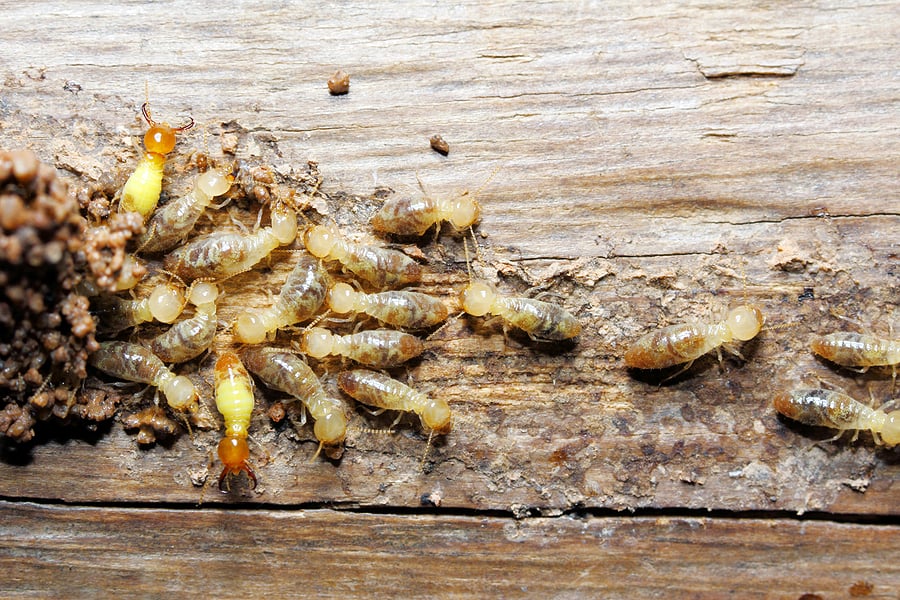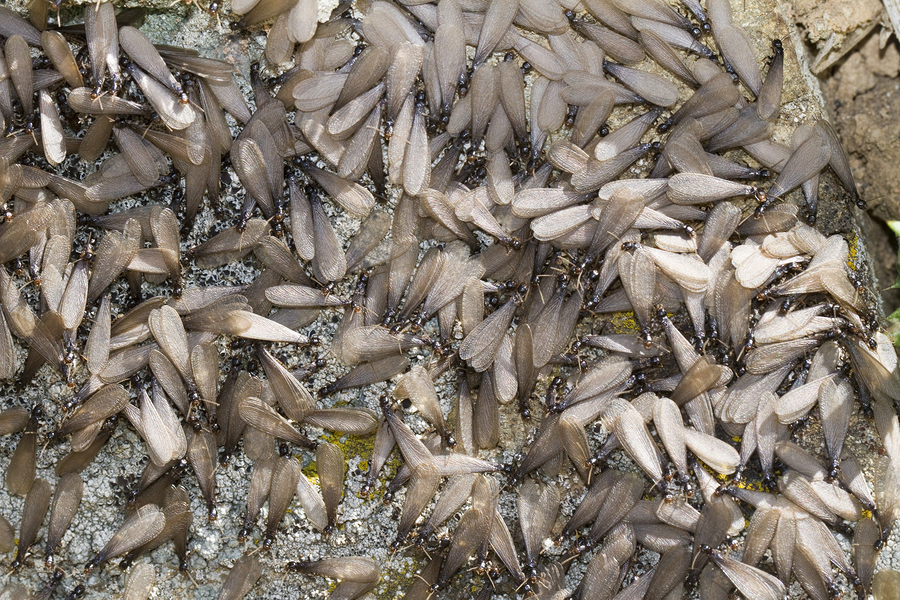READY TO GET STARTED?
REQUEST A FREE ESTIMATE
Fill out the form below or call (888) 466-7849 for a free, no-obligation estimate.

Termites cause billions of dollars in damage to homes each year. This irreparable damage can affect both the structure and the integrity of your home. It is projected that homeowners spend upwards of $2 billion on termite treatments each year. Termites eat wood from the inside out, allowing them to go undetected for long periods of time and causing significant damage before you even realize it. Oftentimes homeowners aren’t aware of the presence of termites until they discover this damage.
The most common type of termite in the United States is the subterranean termite, although drywood termites, dampwood termites and Formosan termites can also be found here. Some of the most common signs of termites in your home include termite swarms; mud tubes on or around foundations; piles of discarded wings; drooping or discolored drywall; paint that is peeling; wood that makes a hollow sound when you tap on it; squeaking floorboards; doors and windows that stick; damaged or crumbling wood; loose tile; buckling floors; and even small holes in your drywall.
There are three main methods of termite treatment and the effectiveness of each depends on the type of termite you are dealing with and the severity of the infestation. Here is a breakdown of all three, along with some termite prevention tips to help protect your home from termite damage.
Soil treatments are applied to the soil that surrounds your home to create a barrier. The first step is to dig a trench around your foundation. This soil is then treated with a termiticide and the trench is filled back in. By doing this, termites are killed as they pass through the chemicals on their way back to their nests.
Wood treatments are used to both kill existing termite colonies and also prevent future ones from starting. There are different types of wood treatments all used with varying effectiveness depending on the type of termite and the severity of the infestation. Surface sprays are treatments that are applied to the surface of wood. Injected sprays and foams are applied to the inside of wood. Borate treated wood is wood that is pretreated with a borate solution. Gas fumigation entails using fumigants that permeate throughout your entire home which disrupts the metabolism of the termites. Surface sprays and borate treated wood are usually used during construction or renovation of homes. Injections, foams, and fumigants are used after a home is built.
Bait systems are most effective at destroying termite colonies. A termite control professional will come out and install the bait stations around the outside perimeter of your home. These stations are then monitored on a regularly scheduled basis. Bait stations help ensure your home is protected from both a current infestation and a future one. The bait stations contain chemicals that termites eat and then take back to their colonies which allows it to be spread to others. This type of termite treatment is most effective with larger termite colonies.
How do you know which type of treatment is best for you? That all depends on the type of termite you are dealing with. Subterranean termites typically nest underground and enter homes where the wood structure makes direct contact with the soil. They will often squeeze through cracks in the foundation or around utility pipes through mud tubes. The best treatment for these termites is either a soil treatment or a bait station.
Drywood termites don’t require direct soil contact for survival. These termites will colonize anywhere they can find a preferred source of wood. They also don’t need as much moisture to survive like other termite species do. Drywood termites are often found in attics, dead or dying trees and shrubs, utility poles, fencing, and furniture. These termites are most effectively treated with gas fumigation or targeted termiticide.
Dampwood termites are much larger in size than their subterranean counterparts. They also have large pincers that they use to fight off predators. They typically colonize damp or decaying wood with higher moisture content like that found in logs and stumps. These termites don’t usually make their nests in the soil or build mud tubes. They are also not usually as destructive as other termite species are. The best treatment for these termites is moisture removal and termiticide application.
The best way to get a head start on termite control at home is through prevention. Most homeowners policies do not cover termite damage so keeping them away is critical to protect both your home and your wallet. You can prevent termites by:
If you suspect you have a problem with termites or you just want to get ahead with a prevention plan, contact your local pest control company who can provide you with a free analysis and set you up with a successful treatment and prevention plan going forward.
The Importance of Mosquito Treatments
How to Prepare for Snake Season

You probably aren’t too concerned with termites just yet, with the recent icy weather here in Georgia and the Southeast. BUT…prevention is key to preventing termite damage and now is the time to get prepared.
In the South, termites start swarming in early Spring. So if you don’t already have a termite control plan, it’s time to think about getting one. While swarming termites do not cause structural damage, it’s a sign that a termite colony is hard at work nearby. This could mean severe structural damage to your home that will result in hundred and thousands of dollars in repair costs. So what’s the solution?
There are several methods of termite control and deciding which termite treatment is right for your home can be overwhelming. After all, we’re talking about protection for one of your largest investments! And since termite damage typically isn’t covered by homeowners insurance, it’s important to not only have your home treated, but to have a solid termite warranty.
If you have a really good understanding of how termites work, you could attempt DIY termite control. There are several options for this from traditional liquid barrier treatments to termite baiting systems. This can be a difficult task if you have any slabs attached to your home or a basement. A liquid barrier must be complete with no breaks in order to keep termites out. Want a pro? Keep reading.
Some pest control companies will recommend a liquid treatment if you have active termites or damage. This provides instant and long-term termite protection. Make sure your termite company includes a good warranty with your treatment, ideally one that covers termite re-treatments and any damage caused post-treatment.
This type of termite treatment is ideal when your home is in the construction phase. The wood frame is treated with a product called borates, elements from the earth, that will give you permanent termite protection and also help ward off common household pests.
Baiting Systems are proven effective at eliminating entire termite colonies underground around your home, less invasive than liquid treatments, ideal for new and existing construction, and usually come with a lifetime warranty. It’s also the environmentally-responsible way to protect your home from termites, by eliminating the use of hundreds of gallons of chemicals. With Sentricon Always Active, our preferred choice for baiting systems, monitoring devices are placed in the ground strategically around your the perimeter of your home. The devices have a bait tube inside that termites are attracted to. Termites will find the stations, eat the bait and share with their colony, resulting in colony elimination.
1. Keep mulch away from your home’s perimeter. This is a food source for termites.
2. Keep any items made of wood away from your home. Firewood, cross ties, that construction project you’ve been working on…all are potential food sources for termites.
3. Keep your gutters cleaned. Termites love moisture so keeping the ground around your home dry is key.
If you see a swarm of “flying ants”, it’s probably termites. Find out more on how to tell termites from ants here.
Termite swarmers will usually leave behind small transparent wings. If you see anything like this around your home, call an exterminator.
For more specific information on termite control in your area: